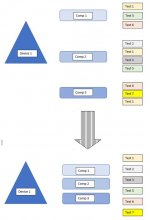Hi all.
Table 1 has list of devices with serial/model number and the date of assignment. Table 2 has a list of complaints. User can have a device assigned with at least one complaint or more brought to the shop for repairs/analysis. Table 3 lists the tests they need to run per complaint. Obviously, some of the tests are common in almost all of the complaints and some of them are needed for fewer number of complaints.
User needs to have a table that holds all Tests per device and its status. User will update the status of each test once he has ran the test. (Test Passed or Finished or something like that). The goal is to have all tests uniquely listed per device.
I thought I am going to need a temp table to list all Tests per device and then remove duplicates from Tests column (per device) before I append my data into another table to store for ever.
I try to show how does it look like by using attached figures. Please let me know if my text or figures are not clear enough.
Am I going to need a temp table or its better to avoid it? Either way I need your suggestions before I can proceed.
Thank you
Table 1 has list of devices with serial/model number and the date of assignment. Table 2 has a list of complaints. User can have a device assigned with at least one complaint or more brought to the shop for repairs/analysis. Table 3 lists the tests they need to run per complaint. Obviously, some of the tests are common in almost all of the complaints and some of them are needed for fewer number of complaints.
User needs to have a table that holds all Tests per device and its status. User will update the status of each test once he has ran the test. (Test Passed or Finished or something like that). The goal is to have all tests uniquely listed per device.
I thought I am going to need a temp table to list all Tests per device and then remove duplicates from Tests column (per device) before I append my data into another table to store for ever.
I try to show how does it look like by using attached figures. Please let me know if my text or figures are not clear enough.
Am I going to need a temp table or its better to avoid it? Either way I need your suggestions before I can proceed.
Thank you




